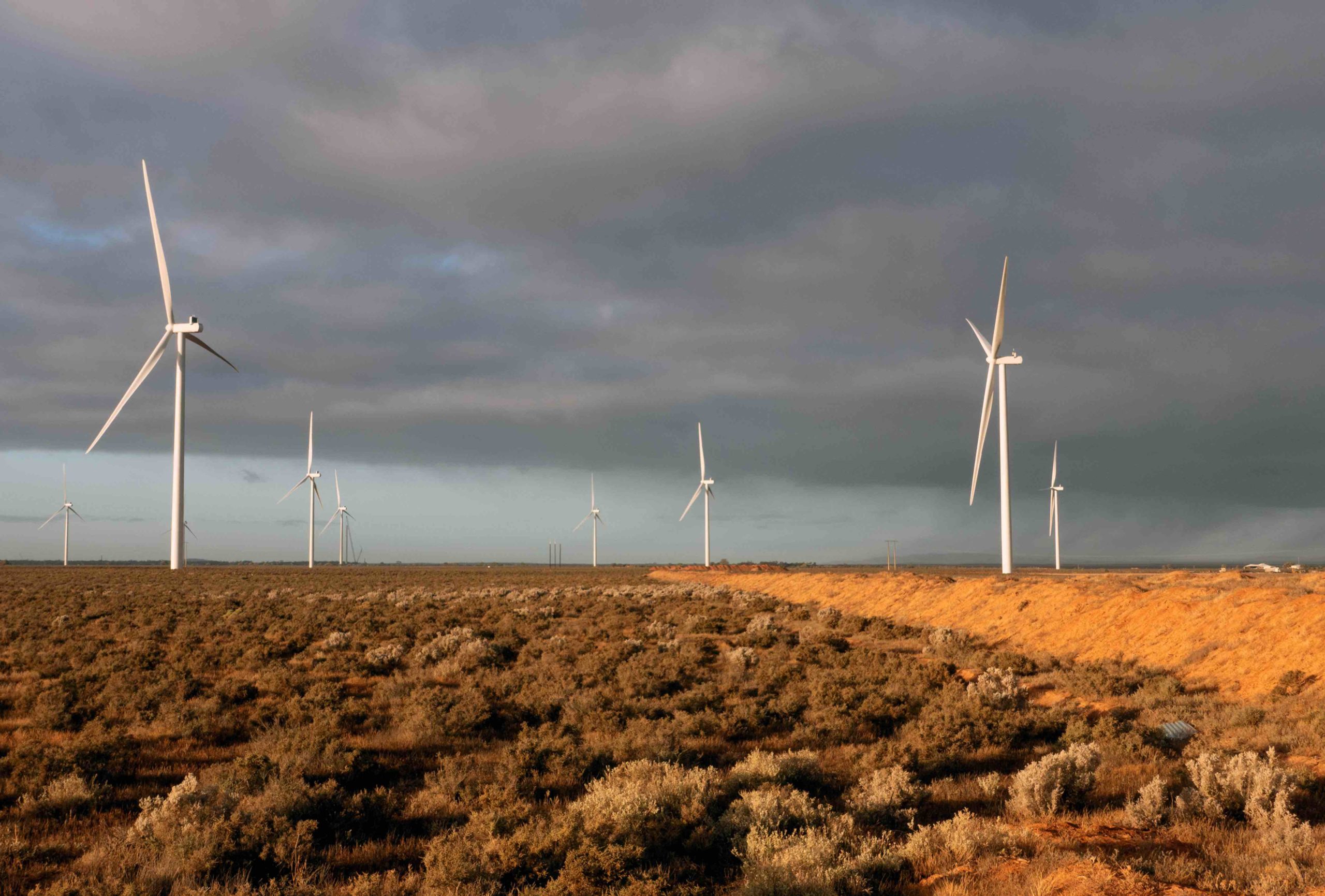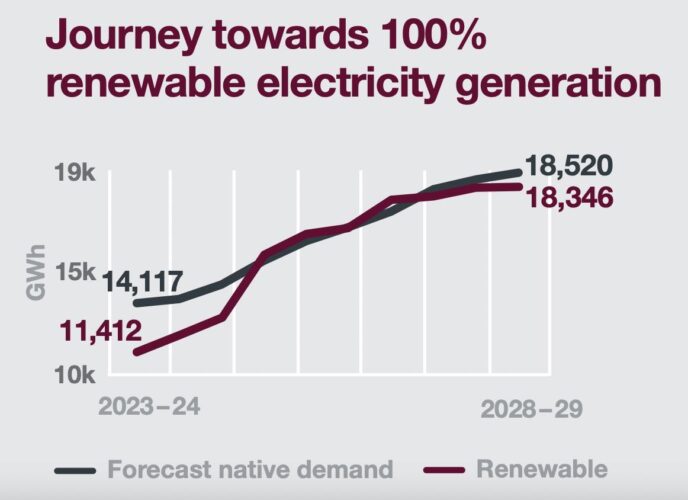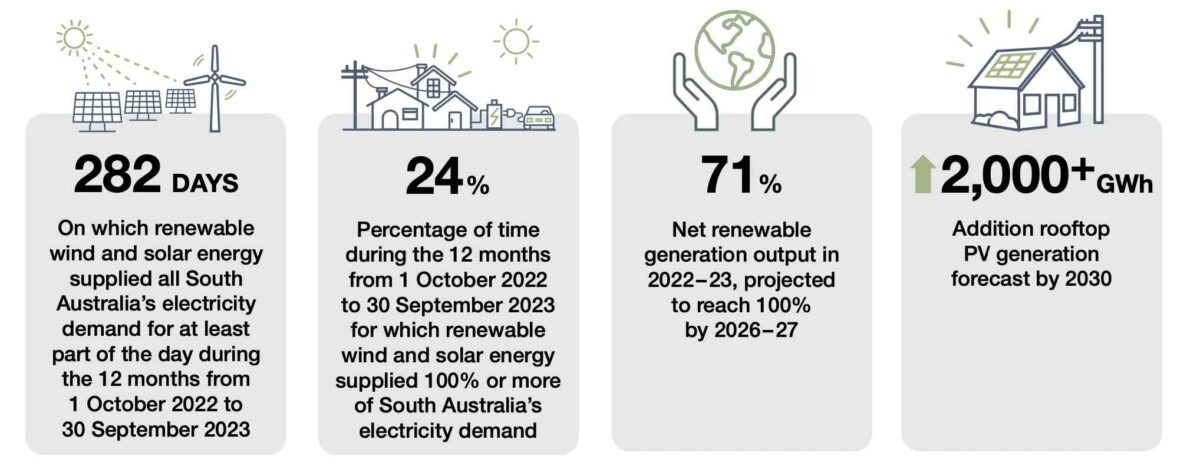South Australia – the state with a world-leading average share of renewable energy of more than 71.5 per cent in its grid – is expected to reach “net” 100 per cent renewables within four years, according to the state’s transmission company.
The stunning prediction by ElectraNet, the first time it has been formally acknowledged by such an authority, is all the more remarkable because in South Australia renewables means wind and solar, because there is no hydro, geothermal or even biomass power to speak of.
South Australia would be the first grid of its size to reach such a milestone. Its share of wind and solar is also unmatched in a grid of its size in a modern economy.
South Australia state governments – be they Liberal or Labor – have long held a prediction that by 2030 the state will average “net” 100 per cent renewables, but it has also been informally recognised that it would get there much earlier, particularly after a new transmission link to NSW is complete in 2025/26.
Now, the state’s main transmission company ElectraNet has formally recognised that, and predicts that the state grid will double in size because of the rush of green industry coming to the state in search of low cost, zero emissions power.
“Net” 100 per cent renewables simply means that the state will export surplus production when needed, and import when needed – as any other connected grid in the world does, be they mostly powered by coal, nuclear, gas or renewables.
South Australia’s ambitions go way beyond just “net” 100 per cent renewables and is intent on tapping into its ample wind and solar resources to build a massive green hydrogen industry.
This will support the production of hydrogen, ammonia and green iron and other metals, and the government has committed nearly $600 million to build a 250 MW hydrogen electrolyser and a 200 MW hydrogen-fuelled power plant, and both will likely be the world’s biggest when built.
The ElectraNet report notes wind and solar supplied all of the state’s electricity demand for at least part of the day on 282 days over the 12 months to September 30, 2023. That equated to 24 per cent of all trading intervals. The share of renewables averaged 71 per cent over that period.
It also notes that 85 per cent of transmission connection points with the SA Power Networks distribution network has experienced times when the output of distributed solar PV systems exceeded the local demand during the day.
“South Australia has demonstrated that operating at 100% instantaneous variable renewable energy is achievable,” ElectraNet says in its planning document. “We will continue to balance affordability with reliability as we transition to a 100% renewable grid.”
The company says the state will reach net 100 per cent renewables within a few years.
More interesting is what follows. ElectraNet says it is receiving “unprecedented” interest in new demand that is driving by electrification, new and expanded mining operations, industrial loads, desalination facilities and energy-intensive operations such as data centres.
All these big energy consumers are searching for low cost, zero emissions renewables and their load will effectively double the size of the state grid. On the supply side, ElectraNet says new zones to the north and west are also attracting huge interest from developers of gigawatt scale projects for new wind and solar.
“We are also receiving enquiries from proponents of increasingly large renewable energy generation developments,” it says.
“Eight of these proposed large- scale generation developments exceed 1,000 MW in size, with interest spanning the state from the South East, through the Mid North, to the Eyre Peninsula.”
ElectraNet’s planning document sites the development of the Mid North Renewable Energy Zone, including the Mid North Southern Expansion and Mid North Northern Expansion, as essential to connecting the new wind and solar and storage capacity needed to meet the expected growth in demand.
Chief Executive Officer, Simon Emms, said South Australia remains a leader in the clean energy transition and ElectraNet network developments are central to energising South Australia’s clean energy future.
“South Australia’s renewable energy is attracting international interest from businesses seeking to invest in a net-zero emissions economy,” ElectraNet CEO Simon Emms said in a statement accompanying the report.
Emms said ElectraNet is on the ground engaging with customers for both new loads and renewable energy developments.
“This is demonstrating the need to strengthen the network backbone as soon as possible through South Australia’s Mid North,” Emms said.
“Now is the time for the timely investment of new transmission to fully capitalise on South Australia’s renewable energy projects to supply growing demand.”












